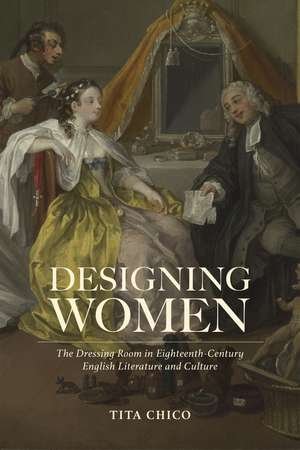Designing Women: The Dressing Room in Eighteenth-Century English Literature and Culture
Autor Tita Chicoen Limba Engleză Paperback – 14 iul 2023 – vârsta ani
Dressing rooms, introduced into English domestic architecture during the seventeenth century, provided elite women with unprecedented private space at home and in so doing, promised them equally unprecedented autonomy by providing a space for self-fashioning, eroticism, and contemplation. Tita Chico’s Designing Women argues that the dressing room becomes a powerful metaphor in late seventeenth- and eighteenth-century literature. While satirists—such as Dryden, François Bruys, Gay, Wortley Montagu, John Breval, Elizabeth Thomas, Pope, and Swift—attack the lady’s dressing room as a site of individual and social degradation, domestic novelists—including Richardson, Lennox, Burney, Goldsmith, Austen, and Edgeworth—celebrate it as a space for moral, social, and personal amelioration.
As a symbol of both progressive and retrograde versions of femininity, the dressing room trope in eighteenth-century literature redefines the gendered constitution of private spaces, and offers a corrective to our literary history of generic influence and development between satire and the novel.
As a symbol of both progressive and retrograde versions of femininity, the dressing room trope in eighteenth-century literature redefines the gendered constitution of private spaces, and offers a corrective to our literary history of generic influence and development between satire and the novel.
Preț: 325.69 lei
Nou
Puncte Express: 489
Preț estimativ în valută:
62.33€ • 64.99$ • 51.80£
62.33€ • 64.99$ • 51.80£
Carte indisponibilă temporar
Doresc să fiu notificat când acest titlu va fi disponibil:
Se trimite...
Preluare comenzi: 021 569.72.76
Specificații
ISBN-13: 9781684484799
ISBN-10: 1684484790
Pagini: 302
Ilustrații: 2 bw
Dimensiuni: 152 x 229 x 20 mm
Greutate: 0.4 kg
Editura: Bucknell University Press
Colecția Bucknell University Press
ISBN-10: 1684484790
Pagini: 302
Ilustrații: 2 bw
Dimensiuni: 152 x 229 x 20 mm
Greutate: 0.4 kg
Editura: Bucknell University Press
Colecția Bucknell University Press
Notă biografică
TITA CHICO is a professor of English and faculty director of the Center for Literary and Comparative Studies at the University of Maryland in College Park. She is the author of, most recently, The Experimental Imagination: Literary Knowledge and Science in the British Enlightenment, as well as the forthcoming, On Wonder.
Cuprins
Preface
The Dressing Room Unlock’d
Acknowledgments
Part I: Metaphor, Theory, and History
Chapter 1
Women’s Private Parts: The Politics and Aesthetics of the Dressing Room
Chapter 2
‘‘The Art of Knowing Women’’: A History of the Dressing Room
Part II: Satire, Art, and Epistemology
Chapter 3
‘‘A painted woman is a dang’rous thing’’: Dressing Rooms and the Satiric Mode
Chapter 4
The Arts of Beauty: Women’s Cosmetics and Pope’s Ekphrasis
Chapter 5
The Epistemology of the Dressing Room: Experimentation and Swift
Part III: Domestic Novels, Education, and Motherhood
Chapter 6
Richardson’s Closet Novels: Virtue, Education, and the Genres of Privacy
Chapter 7
From Maiden to Mother: Dressing Rooms and the Domestic Novel
Coda
Vanity Knows No Limits in a Woman’s Dressing Room’’
Notes
Bibliography
Index
The Dressing Room Unlock’d
Acknowledgments
Part I: Metaphor, Theory, and History
Chapter 1
Women’s Private Parts: The Politics and Aesthetics of the Dressing Room
Chapter 2
‘‘The Art of Knowing Women’’: A History of the Dressing Room
Part II: Satire, Art, and Epistemology
Chapter 3
‘‘A painted woman is a dang’rous thing’’: Dressing Rooms and the Satiric Mode
Chapter 4
The Arts of Beauty: Women’s Cosmetics and Pope’s Ekphrasis
Chapter 5
The Epistemology of the Dressing Room: Experimentation and Swift
Part III: Domestic Novels, Education, and Motherhood
Chapter 6
Richardson’s Closet Novels: Virtue, Education, and the Genres of Privacy
Chapter 7
From Maiden to Mother: Dressing Rooms and the Domestic Novel
Coda
Vanity Knows No Limits in a Woman’s Dressing Room’’
Notes
Bibliography
Index
Recenzii
“In this eloquent and sophisticated book, Tita Chico elucidates the multiple and changing significations of the dressing room in eighteenth-century satirical writing and the domestic novel. In doing so, Chico draws on, and rewardingly complicates, a rich and influential body of work on gender and satire, as well as recent scholarship on space, domestic architecture and eighteenth-century literature."
“[A] lively and sophisticated account of one of the most visible and provocative places in eighteenth century English culture, the lady’s dressing room. More than simply an exposition of the dressing room’s broad significance in a single historical moment, Tita Chico’s study shows how the meaning and functions of the dressing room change through history.”
“In showing us the dense, complicated, and flexible trope of the dressing room, Chico has demonstrated that representations of women through space invests their bodies—and their selves—with a number of potential associations. In real houses the dressing room was a flexible space which allowed for both women’s autonomy and containment. In literature too, the dressing room is a place where women have been objectified, but also where women have been given the independence to become authentically themselves.”
“Her study is articulate, well-grounded, and thoughtfully argued.”
Descriere
As a symbol of both progressive and retrograde versions of femininity, Designing Women establishes the dressing room trope in eighteenth-century literature as redefining the gendered constitution of private spaces, and offers a corrective to our literary history of generic influence and development between satire and the novel.
